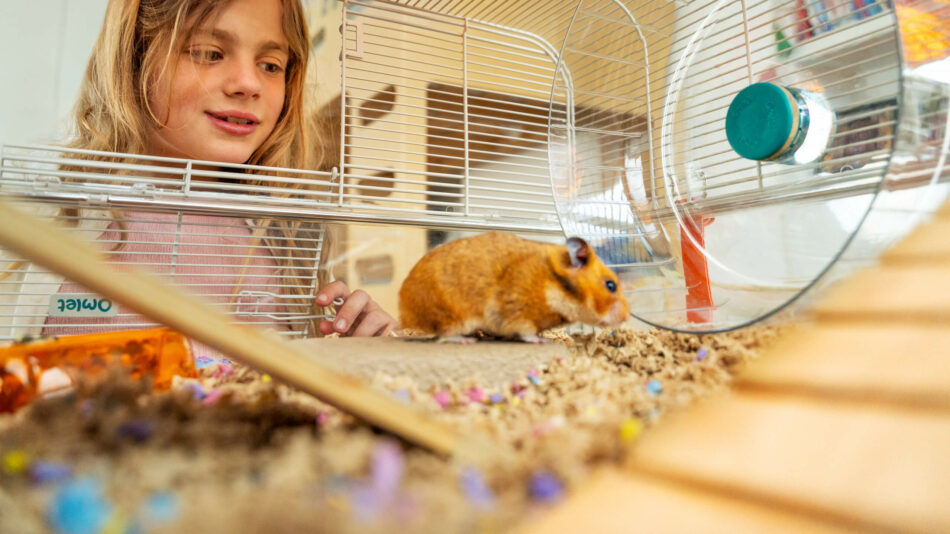Hamster care 101
Bringing a small pet into your home comes with big responsibilities — and hamster care 101 is your essential guide to understanding what life with one of these furry little friends is like. Because of their compact size, relatively low-maintenance care regimen, and endless supply of entertainment, hamsters are popular pets across many age groups. But to truly thrive, hamsters need more than just a wheel and a handful of food pellets. They need thoughtful care, appropriate housing, and a good understanding of their natural behaviors.
The keys to hamster happiness
Hamsters may be tiny, but their care is multifaceted: diet, habitat, hygiene, social needs, health, and overall wellbeing are all key factors to a happy, healthy hamster. Understanding their unique needs will help you provide a safe and supportive home for your hamster, and help you enjoy the companionship they offer in return.
What are hamsters like as pets?
Hamsters are nocturnal, independent, and full of personality. Most species — particularly Syrian hamsters — prefer to live alone and can become territorial when housed with others. While some enjoy gentle handling, especially if socialized young, many hamsters are quote content doing their own thing. They’re tidy animals, surprisingly smart, and can be trained to use a specific spot as their toilet within their enclosure (much like a litter box).
Watching a hamster burrow, forage, and navigate tunnels is a joy in itself. Since they’re nocturnal, they’re great pets for people who are home during the evenings to provide interaction and enrichment when hamsters are naturally awake and active.
A hamster’s diet
A balanced diet is essential for a hamster’s long-term health. Commercially bought hamster blends — typically a mix of seeds, grains, and pellets — serve as a good foundation, but variety is key when feeding your hamster.
What to feed your hamster:
- A high-quality hamster pellet feed, with a modest amount of seeds mixed in. Avoid colored pellets or feeds that closely resemble trail mix, as hamsters will pick out the bits they like most, leaving essential nutrients behind.
- Fresh vegetables like carrots, cucumbers, and broccoli in small portions 2-3 times a week.
- Occasional fruits like apples, bananas, or berries as a treat. Offer in moderation due to the natural sugar content.
- Protein sources like mealworms or pieces of boiled egg.
Always provide fresh, clean water. Avoid citrus fruits, onions, garlic, chocolate, and anything processed or sugary — these can be harmful for your hamster’s digestive system.
Housing your hamster
Hamsters need much more space than people assume. A common misconception is that the popular design of a small plastic cage is enough — but in reality, hamsters benefit from a large enclosure with plenty of enrichment opportunities.
Ideal hamster housing includes:
- A spacious hamster habitat with solid flooring
- Deep bedding for burrowing
- A hamster hideout
- A solid hamster wheel
- Hamster tunnels, ramps and platforms, and scatter feeding in a hamster playpen to encourage natural behaviors
Hamsters are experts at climbing and chewing, so an escape-proof enclosure is essential for keeping them safe and secure.
Cleaning routines
Hamsters are surprisingly clean and will often designate a toilet area for themselves within their enclosure. That said, maintaining a hygienic home by cleaning your hamster’s habitat is essential for their health and comfort.
How to clean your hamster’s habitat:
- Spot clean daily to remove soiled bedding
- Refresh food and water daily
- Deep clean their habitat once every 2-4 weeks by fully replacing the bedding, wiping down smooth surfaces and accessories, and washing their food bowl
Avoid over-cleaning, as full-habitat cleanouts can stress your hamster by removing their familiar scents. Spot clean as much as possible before performing a full bedding change, and aim to clean their habitat during their waking hours when they can spend time in a hamster playpen.
Social needs
Hamsters are generally solitary animals. Syrian hamsters in particular should always be housed alone. Dwarf species such as Roborovskis or Campbell’s may coexist peacefully in pairs or groups, but only if introduced early and carefully — and continually monitored. Still, the safest way to keep a hamster is by itself.
While they may not crave companionship from their own kind, hamsters benefit from regular human interaction — especially if they’ve been gently handled from a young age. Handling should always be calm, slow, and respectful of a hamster’s behavioral cues. Never wake a sleeping hamster for playtime; they can react defensively when startled.
Health care
Though small, hamsters can suffer from a range of health issues. Being prey animals, they tend to hide their symptoms well, so subtle changes in behavior or appearance can be early warning signs. Performing regular hamster health checks will call attention to any deviations from your pet’s normal.
Common hamster health concerns
- Wet tail (diarrhea): this is a serious condition that warrants immediate veterinary care.
- Overgrown teeth: a hamster’s teeth never stop growing, but providing chews will help wear them down.
- Respiratory illness: sneezing, wheezing, or discharge from the nose or eyes may signal an infection or inhaled irritant.
- Skin issues: bald patches or excessive scratching can indicate mites or allergies.
Hamsters don’t require vaccinations, but finding a vet experienced with small animals is crucial for emergencies. Keeping their living area clean, stress low, and diet balanced will help prevent most hamster illnesses.
Important considerations before getting a hamster
Before welcoming a hamster into your home, think through the long-term commitment and environment you’ll provide. Hamsters may be small, but they still need proper care and attention.
Things to consider:
- Lifespan: Most hamsters live 2-3 years.
- Nocturnal habits: Expect some noise while a hamster is most active at night; a child’s bedroom is not an ideal place for their habitat.
- Time and interaction: While lower-maintenance than dogs or cats, hamsters still need daily care and enrichment.
- Responsible sourcing: Choose a reputable breeders or rescue to avoid supporting unethical hamster breeding practices.
Children can enjoy having hamsters as pets, but adult supervision is essential — both for the safety of the hamster and for children to learn proper handling techniques.
Omlet and your hamster
Omlet makes it easy to care for your hamster with products designed around real pet behaviors and modern design. Our hamster habitat is a standout option — sleek, spacious, and designed to be both functional and beautiful in your home. Add accessories like hamster ramps and platforms or a hamster playpen for endless opportunities to bond and play with your pet. Whether you’re new to hamster ownership or are looking to upgrade your setup, we have everything you need to create a healthy, happy environment for your hamster.
This entry was posted in Hamsters


